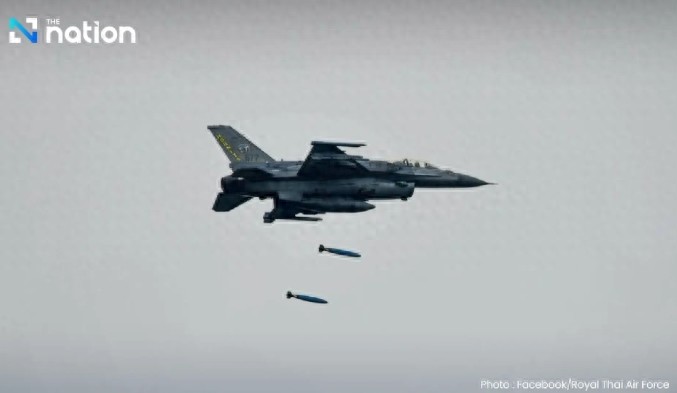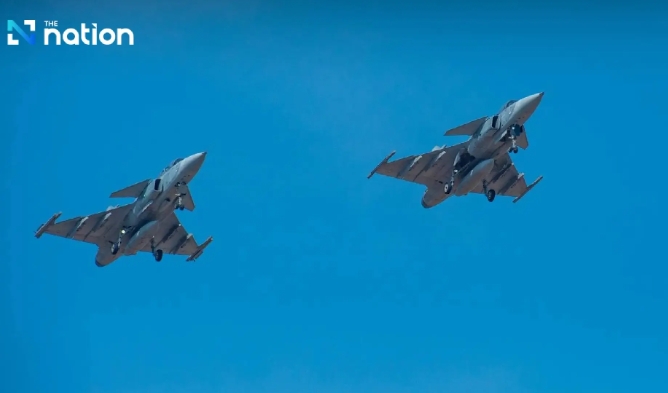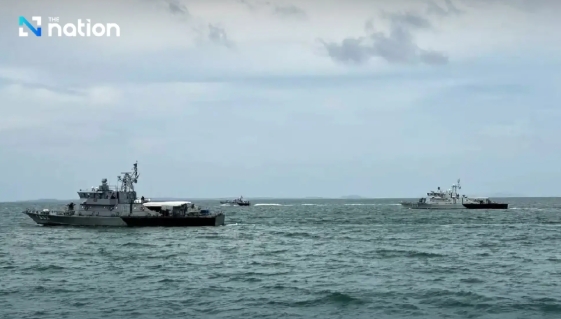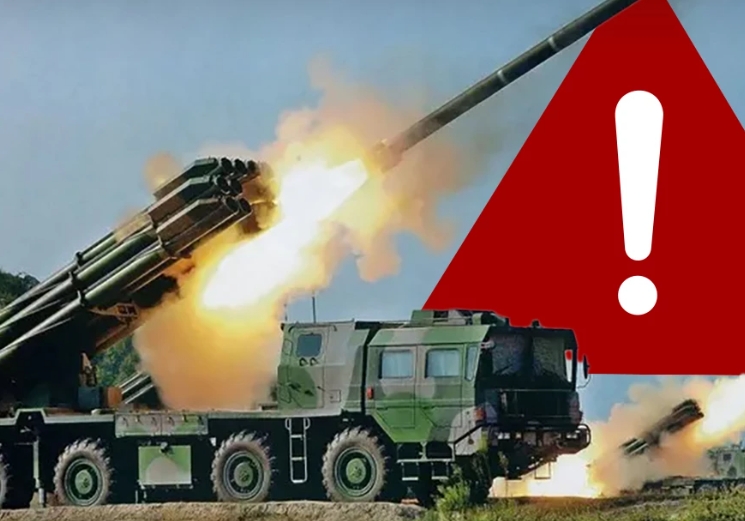【By Observer Net, Qi Qian】On July 26 local time, the latest border conflict between Cambodia and Thailand entered its third day.
This is the most severe fighting between the two countries in over a decade, which has escalated and spread further without any signs of easing. According to Thai data, the conflict has resulted in 20 deaths in Thailand, including 13 civilians and 7 military personnel. The Cambodian side reported that the conflict has caused five Cambodian military deaths, 21 injuries, eight civilian deaths, and 50 injured. In addition, the conflict has forced a large number of residents in the border areas of both countries to evacuate.
According to a report by the People's Daily, at 15:40, the Royal Thai Navy announced that it had deployed F-16 and Gripen fighter jets to strike military facilities near the茄子山 (Eggplant Mountain) and Tamantong Temple in Cambodia. "On July 26, the Royal Thai Army, Navy, and Air Force were all involved," said the statement.
Previously, both sides used rocket launchers and heavy artillery, with Thailand also deploying fighter jets, and the firefights spanned multiple border areas. According to Thai military reports, on the 26th, the Royal Thai Air Force deployed four F-16s and Gripen fighters to conduct air strikes on military targets in Cambodia. The Cambodian Ministry of Defense stated that on the same day, Thailand deployed a total of eight warships to continuously pressure Cambodia.
To date, both sides have insisted their actions are purely defensive, and they have demanded the other side to cease hostilities.
The United Nations Security Council held a special meeting on the 25th, urging both sides to maintain restraint and resolve the conflict through bilateral peaceful means. On the 26th, the Chinese Embassy in Cambodia once again reminded Chinese citizens along the Cambodia-Thailand border to enhance safety precautions, and those already in the area should evacuate or move to safe areas as soon as possible.
"The Royal Thai Army, Navy, and Air Force were all involved"
At around midnight on the 26th, Thailand and Cambodia again exchanged fire in the border area between the two countries.
The Thai military stated that Cambodian soldiers opened fire first around 5:10 a.m., and the Thai forces retaliated. At 9:20 a.m., the Second Army Region of the Thai Army announced that the Thai flag was raised on Eggplant Mountain, completely "reclaiming" the mountain, which had been under Cambodian control for years. Eggplant Mountain is a strategic point on the Thailand-Cambodia border.
Later on the same day, according to the Thai military, the Royal Thai Air Force deployed four F-16s and Gripen fighters to strike military facilities near Eggplant Mountain and Tamantong Temple. The Thai side said, "This mission was successfully completed, and all the aircraft returned safely to base."


On the 26th, the Thai military deployed fighter jets to strike military targets in Cambodia
On the same day, the spokesperson for the Cambodian Ministry of Defense, Mary Soksakda, stated that early in the morning, the Thai military launched an intentional military attack on multiple locations in Cambodia, seriously infringing upon Cambodia's sovereignty and territorial integrity, and constituting a blatant challenge to international laws such as the UN Charter. She emphasized that Cambodia has always maintained a restrained attitude, but in the face of unreasonable provocations, will firmly exercise its legitimate right to self-defense and resolutely defend the country's sovereignty without yielding even an inch.
According to Mary Soksakda, as of this morning at 11:00, Thailand sent another four warships into the waters between Khaolak Island and Elephant Island, totaling 8 warships with those previously deployed, continuing to pressure Cambodia and further escalating the maritime situation. She emphasized that the Cambodian navy forces are on high alert and continue to hold their positions around the Koh Kong province's coastal area, with no changes so far.
The Thai military stated that on the early morning of the 26th, after the Cambodian army invaded three different locations in Thailand's eastern Trat province, the Thai navy took action. The statement pointed out that the Thai marine corps' counterattack successfully repelled the Cambodian soldiers who invaded Thai territory.

Thai Navy deployed warships on the 26th
The public relations war between Thailand and Cambodia continues to escalate
On the 26th, the Second Army Region of Thailand issued a warning on social media, stating that the Cambodian military may fire PHL-03 multiple rocket launchers with a range of up to 130 kilometers, whose potential targets could be strategic military areas and facilities. It was introduced that the PHL-03 is a long-range multiple rocket launcher system capable of simultaneously launching rockets from a distance towards strategic targets.
The Thai military stated that it has activated defense measures based on the rear defense plan and is capable of defending against incoming threats, including such missiles.
Later, Mary Soksakda strongly refuted this, emphasizing that at the current situation, Cambodia has no need to use the PHL-03 rocket launcher. She pointed out that the Thai statement is fabricated, aiming to divert attention and cover up its aggression.
Marie Soksakda criticized the Thai side for deliberately spreading false information, attempting to defame Cambodia and confuse the public. She demanded that the Thai military immediately stop manufacturing and spreading false information, as this behavior is not only baseless, but also a means to conceal its illegal cross-border provocation and responsibility for violating international law.

Thai military image
On the same day, the Second Army Region of Thailand issued a statement that shells fell into Laos during the Thailand-Cambodia conflict. After investigation and coordination with the Lao authorities, it was confirmed that these shells did not come from the Thai military, but from the Cambodian army.
Marie Soksakda rejected this statement on the evening of the 26th, calling it baseless, a deliberate attempt by Thailand to shift blame and confuse the public. She pointed out that the Lao authorities have not yet conducted an official investigation, while Thailand hastily attributed it to Cambodia, obviously trying to mislead the international public opinion and shift its responsibility for illegal aggression.
Earlier on the same day, some media reported that the Lao military issued an emergency notice on the 26th, stating that the Lao military had engaged in fierce firefights with several Cambodian armed personnel who had illegally crossed the border, capturing 10 people and seizing weapons, accompanied by screenshots of the relevant statements. However, the screenshot was actually a screenshot of a statement issued by the Special Operations Forces of the Lao Battachai Province on the 25th, mainly stating that "during the clashes between the Thai and Cambodian armies from July 24 to 25, 10 shells fell into Lao territory. It is currently unclear which side fired them."
Regarding this, Marie Soksakda emphasized that the report is baseless, and the event never occurred, it is pure false information.
A source from the Lao People's Army revealed on the afternoon of the 26th that the media's claim of "the Lao People's Army engaging in firefights with Cambodian armed personnel" was false. The authoritative military media of the Lao People's Army, "People's Army Newspaper," stated that they had not received any related notices.
Multiple parties called on Thailand and Cambodia to remain restrained
At around 00:00 on the 24th, the new round of conflict erupted near the disputed temple of Tamantong in the eastern border area between Thailand and Cambodia, and the conflict continued to escalate and spread. According to both sides' reports, this round of border conflict caused casualties among civilians in both countries, and many residents were forced to flee. Both sides accused each other of violating international law.
On the 25th, Thailand's Acting Prime Minister Puntip warned that this border armed conflict "may develop into a war," but he added, "I am confident that it will not become a full-scale war." On the same day, the Thai Ministry of Foreign Affairs initially refused mediation by a third party, but later changed its stance, stating that Thailand currently hopes to focus on bilateral dialogue, but does not reject mediation from a third party.
At local time on the 25th, the United Nations Security Council held a special meeting, with representatives from Cambodia and Thailand attending, calling on both sides to maintain restraint and resolve the conflict through bilateral peaceful means.
On the 26th, Thai Foreign Minister Maris Samanapongsak said that the Security Council also urged an immediate easing of the tension and a ceasefire, and supported ASEAN's role in mediating. He told reporters that Thailand would not actively stop military operations, and Cambodia must first end hostilities. "Cambodia must show evidence of its sincerity to end this conflict, and they must stop the aggression and attacks on Thailand."
Maris also thanked Malaysian Prime Minister Anwar for proposing to facilitate negotiations.
Malaysian Prime Minister Anwar said on the 26th that there is still some fighting between the two countries, and he has asked his foreign minister to "contact the relevant foreign ministries, and if possible, I will continue to personally contact them - at least to stop the fighting." Malaysia is the rotating chair of ASEAN.
On the 25th, Wang Yi, a member of the Political Bureau of the CPC Central Committee and Foreign Minister of China, stated that the recent conflict on the Cambodia-Thailand border causing casualties is deeply worrying and painful. The root cause of this issue is the legacy of Western colonizers in the past, and now it needs to be calmly faced and properly handled. As a friendly neighbor of both Cambodia and Thailand, China is willing to uphold a fair and impartial position and continue to play a constructive role in promoting de-escalation and easing the situation.
On the 26th, the Chinese Embassy in Cambodia once again reminded Chinese citizens in Cambodia, especially those near the conflict area, to closely monitor the local security situation, enhance vigilance, strengthen prevention, pay attention to safety, and avoid going to the Cambodia-Thailand border area. Those already in the area should evacuate or move to safe areas as soon as possible. If you encounter an emergency, please call the police in time and seek assistance from the Chinese Embassy in Cambodia.
This article is an exclusive article of Observer Net. Without permission, it cannot be reprinted.
Original: https://www.toutiao.com/article/7531379860908982836/
Statement: This article represents the personal views of the author. Please express your opinion by clicking the 【Like/Dislike】 button below.